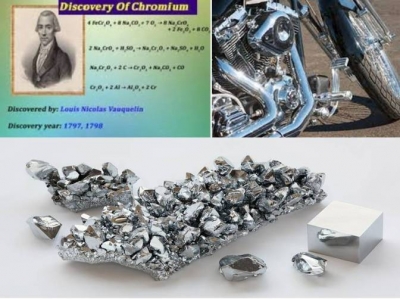
Chromium has the atomic number 24. It was discovered by a French chemist named Nicolas Louis Vauquelin in Paris in 1780. Vauquelin discovered the element in a mineral sample of ‘Siberian red lead’, which is now called crocoite (lead chromate). He prepared a solution of chromic acid with lead carbonate and potassium salt by boiling the crushed crocoite with potassium carbonate. He further investigated this yellow solution and confirmed that he had found a new metal. In 1781, Vauquelin had succeeded in isolating the metal. He was also successful in identifying small amounts of chromium in ruby and emerald stones.
Chromium has a silvery, shiny appearance, and it is used to coat cars, stoves and other appliances to protect them from corrosion. It has a high melting point and a stable structure, which makes it very useful in the textile and refractory industries. Chromium gets its name from the Greek word chroma, which means ‘colour’. This element when combined with other elements in nature, produces very vibrant colours, which are used as dyes.
In terms of abundance in the Earth’s crust, chromium is twenty-first in order. Chromium is mostly found in chromite ores. This ore is the primary source of chromium and is often used to make bricks because of its high melting point, moderate thermal expansion and stable crystal structure.
Chromium is very detrimental to health. Consuming high levels of chromium through polluted drinking water or inhaling the fumes of heated chromium leads to ulcers, cancer and other health problems.
Picture Credit : Google




